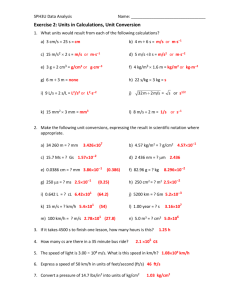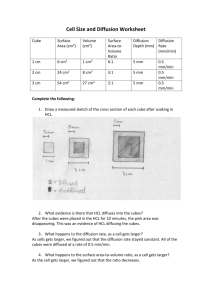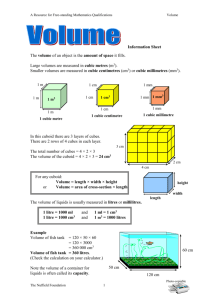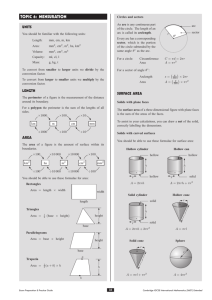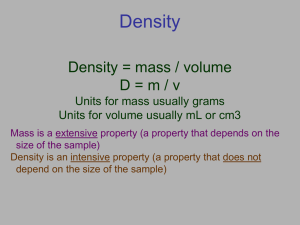Perimerer, Area and Volume
advertisement
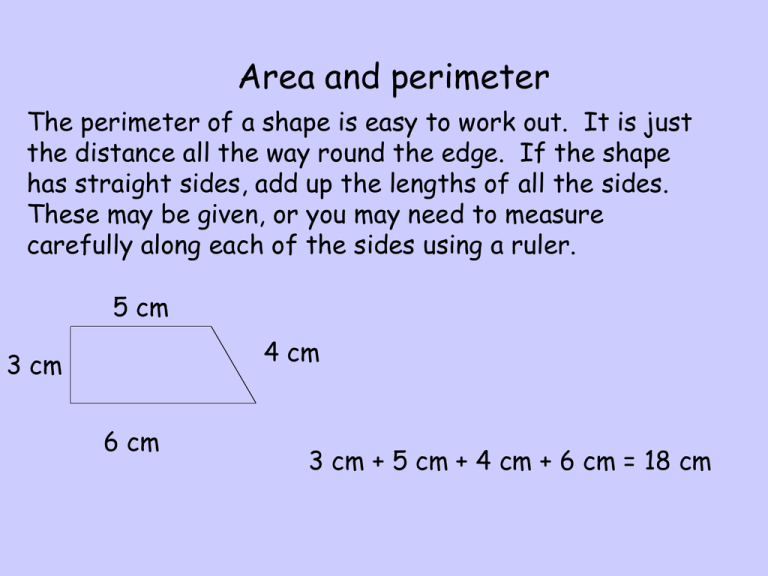
Area and perimeter The perimeter of a shape is easy to work out. It is just the distance all the way round the edge. If the shape has straight sides, add up the lengths of all the sides. These may be given, or you may need to measure carefully along each of the sides using a ruler. 5 cm 4 cm 3 cm 6 cm 3 cm + 5 cm + 4 cm + 6 cm = 18 cm If it has curved sides, a piece of string or cotton may be useful. Go around the edge of the shape and then measure the length of the piece of thread. Finding areas The area of a shape is the amount of surface that it covers. These shapes both have an area of 8 squares Tip: If the shape has curved sides, count all the squares that are bigger than a half Areas of rectangles and shapes Finding the area of a rectangle is easy if you know the length and width: 4 cm 5 cm 4 cm Area = 4 x 4 cm = 16 cm2 3 cm Area = 3 x 5 = 15 cm2 To find the area of a shape that is made up from different rectangles joined together just find the area of each part and then add them together. 2 cm 4 cm Area of big rectangle is 4 x 2 = 8 cm2 2 cm Area of square is 2 x 2 cm = 4 cm2 Total area = 12 cm2 Find the area of each shape 1. = ___cm2 2. = ___cm2 4 cm 3 cm 4 cm 5 cm 3. = ___cm2 3 cm 2 cm 2 cm 3 cm 2 cm 6 cm Measures Equivalent measures Length, mass (or weight) and capacity are all measured using different units. Length 1 centimetre (cm) = 10 millimetres (mm) 1 metre (m) = 100cm 1 kilometre (km) = 1000m Mass 1 kg (kg) = 1000 grams (g) 1 tonne = 1000 kg Capacity 1 litre (l) = 1000 millilitres (ml) 1 centilitre (cl) = 10 ml Imperial measures In the past, we used imperial measures. We still sometimes use pints, gallons, pounds, inches and feet, so it worth knowing these: Remember that means “is approximately equal to” Mass 16 ounces = 1 pound (lb) Length 12 inches = 1 foot 25 g 1 ounce 2.25 lb 1 kg Capacity 2.5 cm 1 inch 30 cm 1 foot 1.75 pints 1 litre 3 feet 1 metre 4.5 litres 1 gallon 8 pints = 1 gallon Volume Volume is a measure of the space taken up by a solid object and is measured in cubic units such as cm3 or cubic metres m3 A solid such as a cube or cuboid is three-dimensional (3D) which means you need three measurements to work out its volume, length, width and height. Each of these diagrams represents a shape made from unit cubes Volume = 8 cm3 Volume = 5 cm3 Remember: 1000 cm3 = 1000 millilitres = 1 litre Each of these 2 cuboids has the same volume, 6 cm3 And the same dimensions: length 3cm width 2 cm, height 1 cm. The volume of the first can be found by counting the unit cubes. The volume of the second is found using the rule: Volume of a cuboid = length x width x height 3 x 2 x 1 = 6 cm3 Volume of a cube = length x length x length = length3 This cube has sides of length 2 cm Its volume is 2 x 2 x 2 = 8 cm3 The most important thing to remember when you are working out practical examples of volume is that all measurements must be in the same units. Example 1: 30cm 20 cm 1m Ann's window box is a cuboid of length 1 m, width 20 cm and height 30 cm. Work out its volume. Make all the units in centimetres 1 m = 100 cm, so the volume is 100 x 20 x 30 = 60 000 cm3 Example 2: Igor is working out how many cubic metres of concrete he will need for his patio. It will be 2 metres wide and 8 metres long and he needs to make it 10 cm deep. How much concrete will he need. Make all the units metres 10 cm = 0.1 m, so the volume is 8 x 2 x 0.1 = 16 x 0.1 = 1.6 m3 Example 3: Bonny has made a rectangular garden pond 2 m long and 1 m wide. She wants to fill it to a depth of 30 cm. How many litres of water will she need? Make all the units centimetres 200 x 100 x 30 = 600 000 cm3 Remember that 1 litre = 1000 cm3 600 000 1 000 = 600 She will need 600 litres of water
